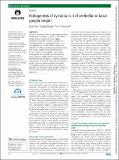Pathogenesis of dystonia: is it of cerebellar or basal ganglia origin?
Author(s)
Kaji, Ryuji; Bhatia, Kailash; Graybiel, Ann M
DownloadPublished version (1.071Mb)
Terms of use
Metadata
Show full item recordAbstract
© Article author(s) (or their employer(s) unless otherwise stated in the text of the article) 2018. All rights reserved. No commercial use is permitted unless otherwise expressly granted. Dystonia is a disorder of motor programmes controlling semiautomatic movements or postures, with clinical features such as sensory trick, which suggests sensorimotor mismatch as the basis. Dystonia was originally classified as a basal ganglia disease. It is now regarded as a 'network' disorder including the cerebellum, but the exact pathogenesis being unknown. Rare autopsy studies have found pathology both in the striatum and the cerebellum, and functional disorganisation was reported in the somatosensory cortex in patients. Recent animal studies showed physiologically tight disynaptic connections between the cerebellum and the striatum. We review clinical evidence in light of this new functional interaction between the cerebellum and basal ganglia, and put forward a hypothesis that dystonia is a basal ganglia disorder that can be induced by aberrant afferent inputs from the cerebellum.
Date issued
2018Department
Massachusetts Institute of Technology. Department of Brain and Cognitive SciencesJournal
Journal of Neurology, Neurosurgery and Psychiatry
Publisher
BMJ